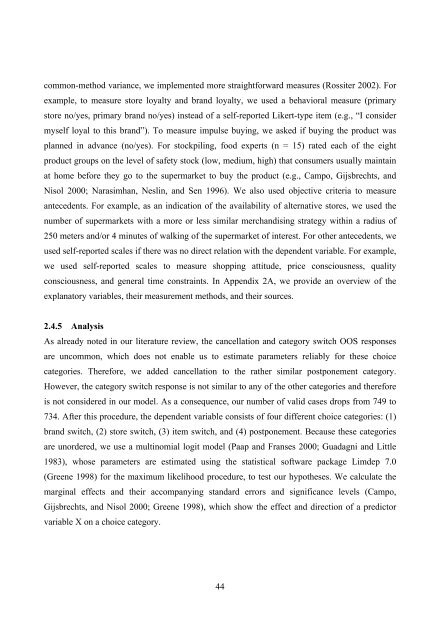Understanding Consumer Reactions to Assortment Unavailability
Understanding Consumer Reactions to Assortment Unavailability
Understanding Consumer Reactions to Assortment Unavailability
You also want an ePaper? Increase the reach of your titles
YUMPU automatically turns print PDFs into web optimized ePapers that Google loves.
common-method variance, we implemented more straightforward measures (Rossiter 2002). For<br />
example, <strong>to</strong> measure s<strong>to</strong>re loyalty and brand loyalty, we used a behavioral measure (primary<br />
s<strong>to</strong>re no/yes, primary brand no/yes) instead of a self-reported Likert-type item (e.g., “I consider<br />
myself loyal <strong>to</strong> this brand”). To measure impulse buying, we asked if buying the product was<br />
planned in advance (no/yes). For s<strong>to</strong>ckpiling, food experts (n = 15) rated each of the eight<br />
product groups on the level of safety s<strong>to</strong>ck (low, medium, high) that consumers usually maintain<br />
at home before they go <strong>to</strong> the supermarket <strong>to</strong> buy the product (e.g., Campo, Gijsbrechts, and<br />
Nisol 2000; Narasimhan, Neslin, and Sen 1996). We also used objective criteria <strong>to</strong> measure<br />
antecedents. For example, as an indication of the availability of alternative s<strong>to</strong>res, we used the<br />
number of supermarkets with a more or less similar merchandising strategy within a radius of<br />
250 meters and/or 4 minutes of walking of the supermarket of interest. For other antecedents, we<br />
used self-reported scales if there was no direct relation with the dependent variable. For example,<br />
we used self-reported scales <strong>to</strong> measure shopping attitude, price consciousness, quality<br />
consciousness, and general time constraints. In Appendix 2A, we provide an overview of the<br />
explana<strong>to</strong>ry variables, their measurement methods, and their sources.<br />
2.4.5 Analysis<br />
As already noted in our literature review, the cancellation and category switch OOS responses<br />
are uncommon, which does not enable us <strong>to</strong> estimate parameters reliably for these choice<br />
categories. Therefore, we added cancellation <strong>to</strong> the rather similar postponement category.<br />
However, the category switch response is not similar <strong>to</strong> any of the other categories and therefore<br />
is not considered in our model. As a consequence, our number of valid cases drops from 749 <strong>to</strong><br />
734. After this procedure, the dependent variable consists of four different choice categories: (1)<br />
brand switch, (2) s<strong>to</strong>re switch, (3) item switch, and (4) postponement. Because these categories<br />
are unordered, we use a multinomial logit model (Paap and Franses 2000; Guadagni and Little<br />
1983), whose parameters are estimated using the statistical software package Limdep 7.0<br />
(Greene 1998) for the maximum likelihood procedure, <strong>to</strong> test our hypotheses. We calculate the<br />
marginal effects and their accompanying standard errors and significance levels (Campo,<br />
Gijsbrechts, and Nisol 2000; Greene 1998), which show the effect and direction of a predic<strong>to</strong>r<br />
variable X on a choice category.<br />
44

















